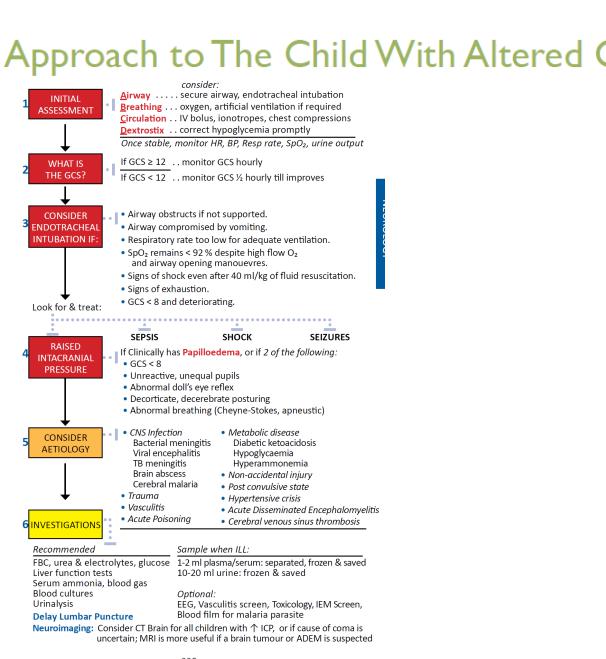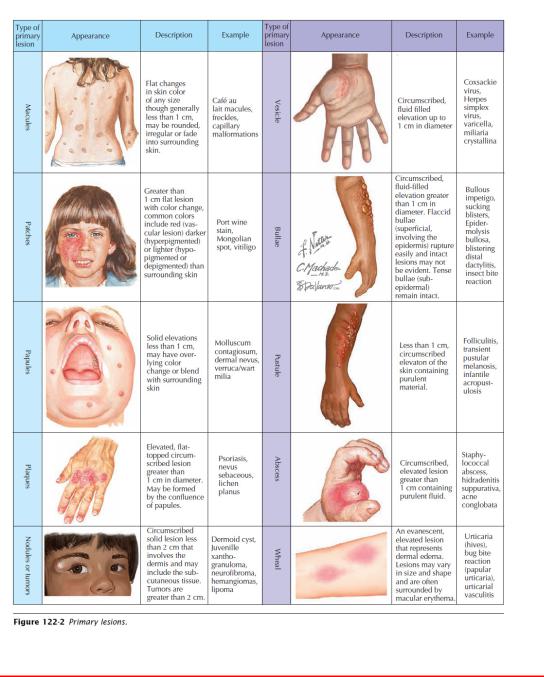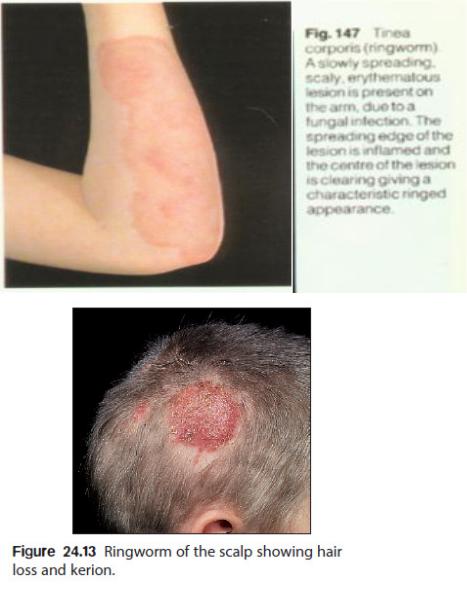
Pediatrics(2)
.pdf-- Congenital abnormalities including brain malformations and hereditary disorders Prematurity
-- Intracranial hemorrhage
-- Asphyxia: Please note that though this is often suspected as the cause, in reality perinatal asphyxia accounts for only a small percentage of cases
-- Cerebral trauma
-- Infections (Bacterial sepsis, meningitis, herpes)
-- Metabolic disturbances (kernicterus, severe prolonged hypoglycemia, Reye’s syndrome)
-- Intoxication (i.e. lead)
-Signs and Symptoms
-Findings are consistent with a specific CNS lesion and commonly include:
-- Spastic syndromes : diplegia, hemiplegia, or quadriplegia
-- dyskinetic syndromes : athetosis, chorea or dystonia
-- Ataxic syndromes
-- Atonic syndromes
-- Abnormal persistence or absence of infantile reflexes
-Complications
-- Intellectual disability
-- Psychiatric disorders : Behavioral, emotional or psychiatric disorders
-- Epilepsy: This occurs in 45% of patients with CP and the onset is
-generally in the first 2 years of life
-- Speech, swallowing, vision and hearing problems
-- Growth failure: This is generally due to poor nutrition
-- Pulmonary disease: This is usually due to chronic aspiration and chronic pulmonary disease is a leading cause of death in patients
-with CP
-- Orthopedic disease: This includes hip and foot deformities and spinal curvatures. Patients may have chronic back, neck, and joint pain
-- Osteopenia: This is multifactorial related to poor nutrition, lack of motility and chronic medication use
-- Urinary disorders including enuresis, urgency, frequency and stress incontinence
-Investigations
-- Neuro-imaging including brain ultrasound, CT or MRI
-- Lumbar puncture if indicated
-- Basic lab-work to exclude other abnormalities (liver and renal function tests)
- - Genetic screening depending on clinical and family history
-- Metabolic screening depending on clinical and family history as well as basic lab work
-- EEG
-- Audiogram and visual evaluation to exclude correctable hearing or vision loss
-- X-rays if indicated
-Management
-- Perinatal asphyxia may be managed by passive or active hypothermia as per neonatology protocols.
-- Pharmacologic management of spasticity:
-• Botulinum toxin injections: Must be done by trained provider.
-• Dantrolene oral 0.5 mg/kg/dose once daily for 7 days, then increase to 1.5 mg/kg divided 3 times/day for 7 days, then increase to 3 mg/kg/day divided 3 times/day for 7 days, then increase to 6 mg/kg/day divided 3 times/day. do not exceed 400 mg/day.
-• Benzodiazepines: dose varies based on medication.
-Diazepam may be used: If 5 years: <8.5 kg: 0.5-1 mg at bedtime; 8.5-15 kg: 1-2 mg at bedtime; >5 years: 1.25 mg given 3 times per day up to 5 mg given 4 times per day.
-• Baclofen oral: <2 years: 10-20 mg divided every 3 times per day, titrate dose every 3 days in increments of 5-15 mg/day to a maximum of 40 mg daily; 2-7 years: 20-30 mg/day divided 3 times per day, titrate dose every 3 days in increments of 5-15 mg/day to a maximum of 60 mg/day, >8 years: 30-40 mg/day divided every 8 hours, titrate dose every 3 days in increments of 5-15 mg/day to a maximum of 120 mg/day.
-• Intrathecal Baclofen: Requires neurosurgical intervention to place pump to deliver medication. The benefits and
-complications should be discussed in detail with the neurosurgeon.
-- Multidisciplinary services to address and promote social and
-emotional development, communication, education, nutrition, mobility and maximal independence and normal appearance.
-• Physical, occupational, and speech language therapy as necessary
-• Social services provided in a variety of contexts to aid in the coordination of care.

-• Nutritional assessment and support for those with dysphagia and/or poor growth
-• Mobility aids including crutches, walkers, or wheelchairs as needed
-• Surgical procedures to correct spasticity, contractures, scoliosis, or hip disorders
-
-

-
Dr: Essam Abdullah 01123232188
-
- 8. Dermatology

- 8.1. Eczema

-
-
-
-Definition: Eczema, also known as dermatitis, is a syndrome characterized by superficial inflammation of the epidermis and itching.
-types
-- Atopic dermatitis: Chronic disease that affects the skin and often occurs together with asthma, dermatitis, rhinitis and conjunctivitis.
-- Contact dermatitis: Acute or chronic inflammation caused by allergens or irritants
-- Napkin (Or diaper area) dermatitis
-Signs and Symptoms
-- Pruritus (constant symptom)
-- And any of the following:
- |
• |
Blisters |
- |
• |
Exudates and Erosions |
- |
• |
Crusting/Excoriations |
-• Xerosis
-• Erythroderma
-Complications
-- Secondary infection (bacterial, viral, fungal, etc)
-- Post inflammatory Hypo or Hyper pigmentation
-- Lichenification
-Investigations
-- Identification of allergens (Prick Skin Test or Patch test)
-- Full blood count (Increase of Eosinophiles)
-Management
-If Atopic dermatitis
-Non-pharmacological management
-• Patient education
-• Recommend Emollient to restore cutaneous barrier
-• Aqueous cream: Apply > 2 times/day
-• Emulsifying Ointment: apply > 2 times/day
-Pharmacological management
-• Local Treatment
-→ Antiseptic – Exudative lesions, Potassium
-permanganate diluted at 1/10,000 (500mg Tablet in 5 liters)
-→ Antibiotics – Impetiginized lesions, Fucidine 2% 1 application/day/5 days
-→ Topical steroids
-■ According to topography and thickness of the lesion
-■ Short course of topical steroid treatment is recommended to avoid local side effects and gradual loss of efficiency
-→First choice
-■ Clobetasol propionate (Dermovate) cream 2 applications/day for 3-4 days, then 1 application/day for 3 days then 1 application
|
every 2 days/week for 2 weeks |
- |
Or |
■Betamethasone dipropionate (Diprosone,
-Diprolene) cream/ointment 2 applications/day

-for 3-4 days, then 1 application/day for 3 days
-then 1 application every 2 days/week for 2 weeks
-→ Alternatives: According to the severity of the lesions and location
-■ Betamethasone valerate (Betneval) cream/
-ointment 2 applications/day for 3-4 days, then 1 application/day for
|
3 days then 1 application every 2 days/week for 2 weeks |
- |
Or |
-■ Methylprednisolone (Advantan) cream/ointment 1 application/day/3-4days then every 2 days/week for 1 week
- |
Or |
-■ Hydrocortisone cream/ointment 2 applications/day for 3-4 days, then 1 application/day for 3days, then 1 application every 2 days/week for 2 weeks
-Note: Side effects of topical steroids:
-- Skin atrophy
-- Skin bleaching
-• Systemic treatment
-→ Sedative antihistaminics: Promethazine Syrup: > 2 yrs of age 7.5-12.5ml at bed time until relief of scratching.
-→ Combined Phototherapy UVAB in Erythrodermic atopic dermatitis
-Recommendations
-- Short duration of topical steroids whenever possible (stop topical steroids as soon as skin lesions disappear)
-- Encourage use of emollient
-- Avoid medicated soap
-- Other eczema, consider topical steroids as indicated in atopic
-dermatitis above
-8.2. Bacterial Infections (Impetigo)
-
-Definition: A contagious intra-epidermal infection caused by
-streptococcus or staphylococcus and presenting as bullous lesions
-which rupture and crust. It comprises of two types namely:
-- non Bullous Impetigo: more common form and is a superficial infection of the skin that appears first as a discrete
-papullovesicular lesion surrounded by a localized area of redness.
-The vesicle becomes rapidly purulent and covered with crust. The lesions may occur anywhere but is more common on the face and extremities. There is usually neither fever nor systemic signs.
-Also occurs in traumatized skin that forms vesicles or pustules initially and rapidly develops crust.
-- Bullous Impetigo: less common and occurs most often in neonates and young infants on a previously healthy skin. It is characterized by transparent bullae usually < 3cm diameter. The distribution involves the face buttocks trunk and perineum. Staphylococcus aureus usually responsible.
-Signs and Symptoms
-- Non Bullous Impetigo
-- Honey colored crusters
-- Adenopathies
-- Bullous Impetigo
-- Flaccid and purulent bullous
-Complications
-- Ulcerations
-- Septicemia
-- Staphylococcal scaled skin syndrome (SSSS)
-Investigation
-- Swab for bacterial culture and sensitivity test
-Management
-- Local Treatment:
-• Antibiotics Fucidic acid ointment (Fucidine 2%) 2 applications/day/7 days
-• disinfectant with antiseptic solution:
-→ Potassium Permanganate diluted at 1/10,000 (500mg in 5 liters)
- |
Or |
-→ chlohexidine solution (dermobacter) 2 applications/ day/7-10 days
-Systemic treatment-diffuse lesions
-• cloxacilline Syrup/Tabs 50mg/kg/day divided in 3 doses for 7 days

-Or
-• Erythromycine Syrup/Tab 50mg/kg/day divided in 3 doses for 7days
-Recommendation
-- Follow-up is important to ensure complete clearing of lesions
-8.3. Fungal Infections
-8.3.1. Dematophytes
-
-
-Definition: Fungal infection often seen as Tinea or Ringworm with
-clinical entities/forms depending on the anatomic site and etiologic agents involved. It is of two types:
